Epson officially jumped into the desktop sublimation printer game in 2020 by launching two dye sublimation printers: the Epson SureColor F570 and the Epson SureColor F170. They come after many crafters and at-home small business have long been converting Epson inkjet printers into sublimation printers by replacing the ink.
But what's the best Epson sublimation printer to go with...the 8.5" wide F170, the 24" wide F570 or a converted Ecotank or Workforce? I'll compare the three options here looking at a number of important factors to help you decide which Epson sublimation printer is best.
Should I Convert an Epson Inkjet Printer to Sublimation?
With the easy access to Epson EchoTanks and WorkForce inkjet printers, along with the low cost of Epson sublimation ink, converting Epson inkjet printers into sublimation printers has becoming increasingly popular.
While it may seem like an attractive option - and especially prior to the launch of the Epson sublimation printers - there are some significant downsides you will want to be aware of.
The Epson dye sublimation printers use special print heads that are intended to be used with sublimation ink. The Epson inkjet printers use a different type of print head. When sublimation ink is put into the inkjet printers, where the print heads are not engineered to handle this type of ink, they corrode the print heads, eventually wearing them down. This could happen over a matter for weeks or months..or if you're lucky years.
The Epson 2720 is the most popular model of Epson printer to convert for sublimation according to an informal poll of Silhouette School readers who have converted Epson printers. The base price of that printer ranges between $250 and $300. The max print size is only 8.5 x 14".
The 13" wide format Epson 15000 was the next most popular printer to be converted for sublimation by Silhouette School readers. It's price tag, in Epson's Amazon store, is close to $1,000 and has a max print size of 13"x19". (Keep those page size in mind as we move through this sublimation printer comparison.)
In addition, putting sublimation ink - even Epson brand sublimation ink - into an Epson inkjet printer immediately voids the warranty. This means when you convert a new Epson Ecotank or Workforce printer to sublimation, you void the 2 year warranty on that printer before you even make your first print.
Epson will not and can not help you troubleshoot.
My suggestion, while I know it's tempting, due to the price and wide availability of some of the inkjet Epson printers is to carefully consider a true Epson sublimation printer instead.
But which one...
Epson F570 vs Epson F170 Sublimation Printers
Before we get to the differences between the Epson F570 and the smaller F170 - let's talk about the similarities.
Both wifi-enabled Epson sublimation printers run on MAC and Windows and BOTH can print directly from Silhouette Studio with the sublimation printer color profiles. In addition both the F570 and the F170 use the same type of ink and include ink with the printer (more on the difference in the amount below).
There are some major differences between the two F170 and the F570 though - some more obvious than others. The size and the price of the printers are the most obvious differences.
The 8.5" wide F170 has a footprint of 13.7" x 13.7" x 7.4 (when not printing) and can print a max page size of 8.5" x 47.2".
The 24' wide F570 has a footprint of 38.2" x 20.7" x 9.6" and can print a max page size of 24.4" wide with the length only limited by the software or operating system being used to send to the printer. Smaller width rolls and sheets can be also be used.
The Epson F170 price is $399. The price of the Epson F570 is $2695.
While the difference in the price of the printers is drastic, it's not quite as drastic when you consider everything that's included with the larger Epson F570 sublimation printer.
The Epson F170 includes the printer and 4 - 140mL bottles of CMYK sublimation inks. Replacement inks sell for about $25 per bottle so consider that there's $100 worth of ink with the smaller F170.
No sublimation material is included.
The Epson F570 however includes not only the 24" wide printer, but 2 full sets of sublimation inks for a total of 8 - 140mL bottles. It also includes 3 rolls of sublimation material: 1 - 24" x 100' (feet) roll and 2 - 17" x 100' (feet) rolls of material. That's an ink and material value of $275 included with the printer.
It also includes the Epson Edge Print software and an extra maintenance tank ($39 value).
Print Quality & DPI Comparison: Epson F570 vs Epson 170
Two differences I did not recognize until I started printing on both the F570 and the F170 and comparing the prints are the amount of material used and the max print resolution or DPI.
Of course with the wider format Epson F570 sublimation printer you can print larger sublimation prints, but you can also print a higher volume of smaller prints faster - and with the less waste!
It took about 11 minutes to print these 6 sublimation tumbler prints and 7 coasters on the highest quality print and slowest speed on a 24" wide roll on the F570.
Had I printed them on the smaller 8.5 x 11" F170 sublimation printers it would have taken eight sheets of Letter size paper and I would have had to set up 8 different pages to print. As a test I printed one of the sublimation tumbler prints on the smaller Epson F170 to see how long it would take to print a single sheet.
It took 2:36...that means it would take more than 20 minutes to print the 8 sheets needed to print all of these prints on an 8.5 x 11" printer. That's almost double the time it took the F570.
Also - because the F570 can print various size rolls and up to 24" you can actually use less material to print the same amount of sublimation prints. Let's look at an example...
Here I have five sublimation coaster prints. The coaster templates are 4" x 4". To print on the F570 I can line them all up in a row across the 24" page and print 5" x 24". That's 120 square inches of sublimation paper needed.
To print on the Epson F170 I can only fit 4 coaster templates on a single 8.5" x 11" sheet which means I have to use two sheets to print the same five sublimation prints. That's 187 square inches of sublimation paper.
As you can see there's more wasted material and the overall amount of material I had to use in the smaller printer was actually more. That can add up in wasted material cost over time.
Another more subtle difference, until you start comparing side by side, is the max dpi of the F570 vs the F170. DPI stands for dots per inch and the higher the DPI the better the print resolution. The Epson F570 has a max dpi of 2400 x 1200 vs the F170 which has a max dpi of 1200 x 600..so half.
I did a lot of testing to see the differences in the print quality between these two Epson printers. (Anyone need coasters..)
I used those same five coaster designs and set them all up the same way in Silhouette Studio. I specifically selected images and photos with a wide range of colors to see how each printer performed at each setting through the Epson print manager: Standard Quality (also called "Speed") vs High Quality (also called "Fine" or "Max Quality").
All five of the coasters were printed in standard quality (not their max DPI) on each printer and again each in high quality (max DPI) to see the side by side differences.
Nothing else about the images or print settings was changed - they were all put on the same coasters. They were all pressed for 60 seconds at 400 degrees on the same heat press. The rest of the print settings and selections were the same.
What you can see are some obvious differences...more than what I was expecting to be honest. First let's just look at the prints themselves.
As a note, I did not edit or color correct any of the below photos in anyway to give you as true a sense of the sublimation print quality as possible..through photos.
This is a side by side of the F570's high quality print setting vs the same printer's standard print quality.
The most dramatic difference is between the F170 standard print quality and the F570 high print quality - which is what I would expect. It's the biggest difference in DPI.
The difference between the print quality was more noticeable on some of the images than others...especially in the oranges, yellows, and blues. The car and sunset prints have the most drastic differences even from standard viewing distance.
Up close there was a noticeable difference on all of the prints with the highest quality, most vibrant, and best resolution being printed with the Epson F570's High Quality "Fine" DPI setting.
Both of the coasters below were printed on the F570. The bottom coaster was printed on standard dpi while the top was printed at max dpi. If you look closely at the two yellows stripes that are side by side, you can see the standard print is more grainy...hence the lower DPI.
What Is the Best Epson Sublimation Printer?
So with all of this information..what do I think is the best Epson sublimation printer? It's a tough question to answer due to the price difference and, let's face it, that's likely going to be a determining factor for a lot of people.
However, similar to an embroidery machine where I now realize why everyone says to buy the biggest hoop machine you can afford (because you'll VERY soon realize you want need it)...I have to say the Epson F570 Sublimation Printer is what I would recommend given all that comes with the 24" sublimation printer as far as extra ink and materials, the wide range of print sizes, the ability to print on rolls and sheets, and the overall better print resolution.
Get Silhouette School lessons delivered to your email inbox! Select Once Daily or Weekly.



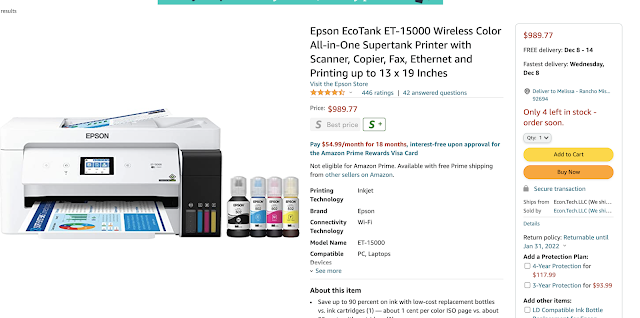
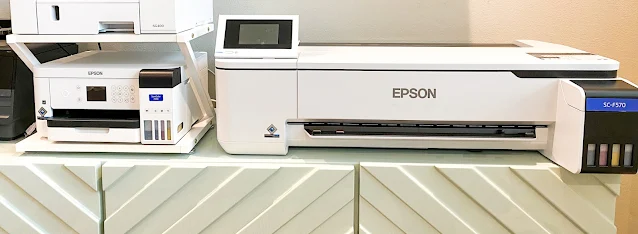
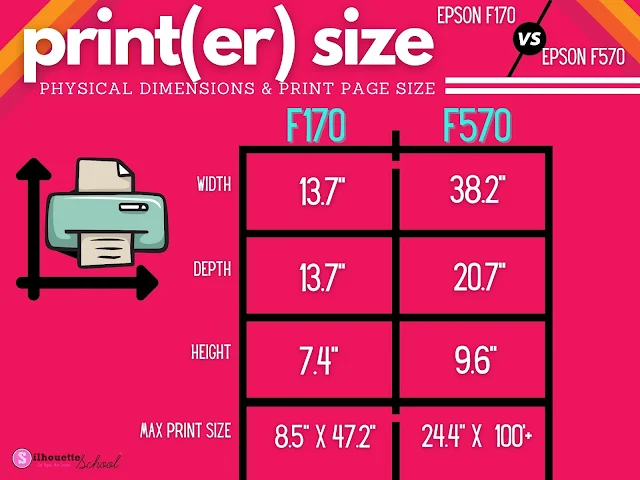


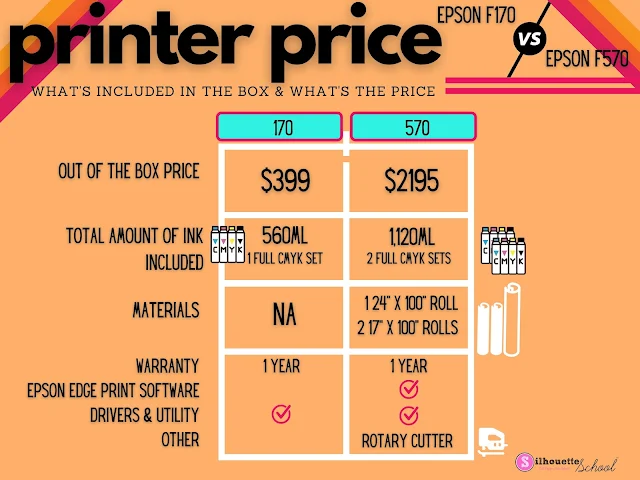

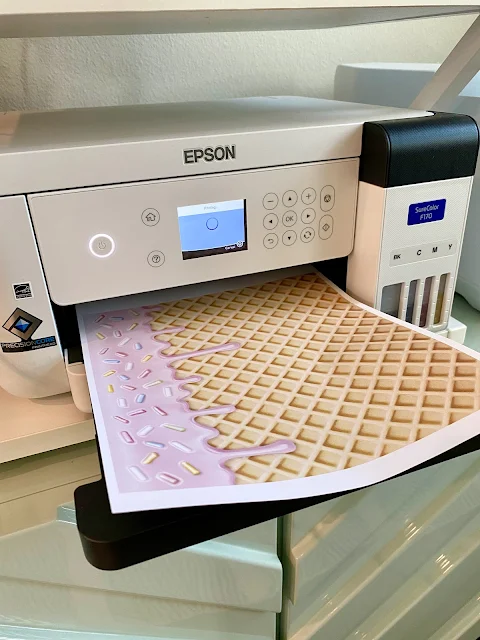
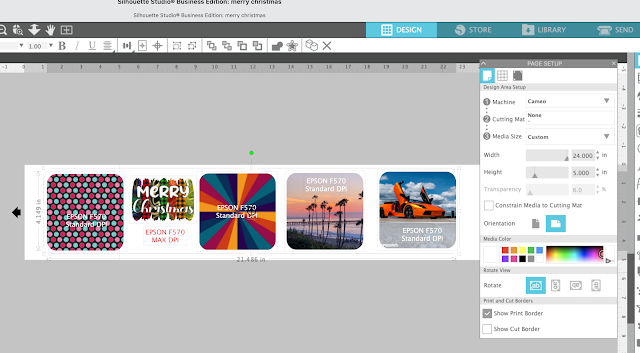
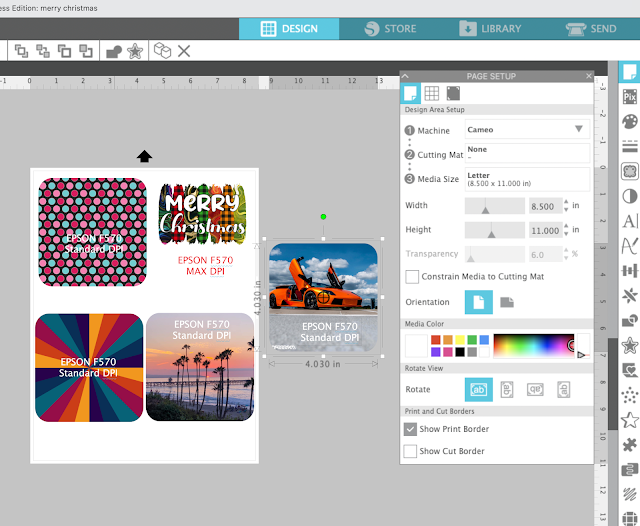
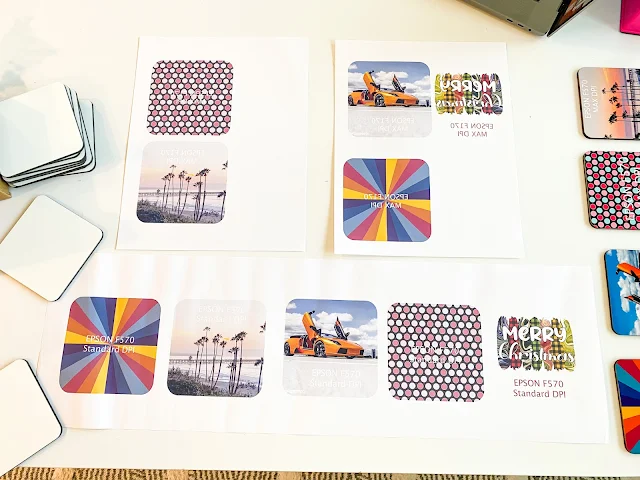
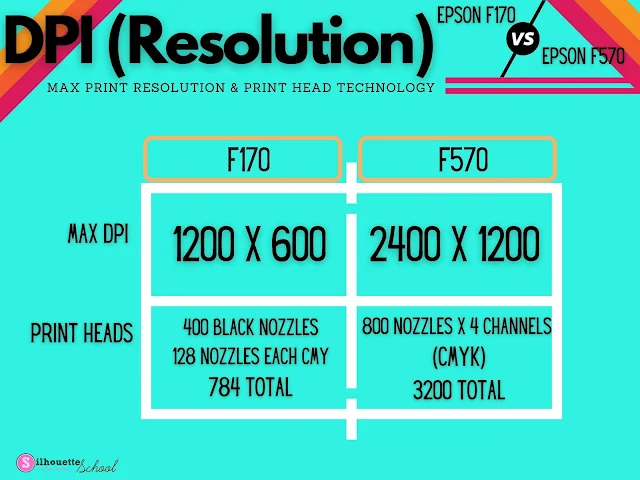
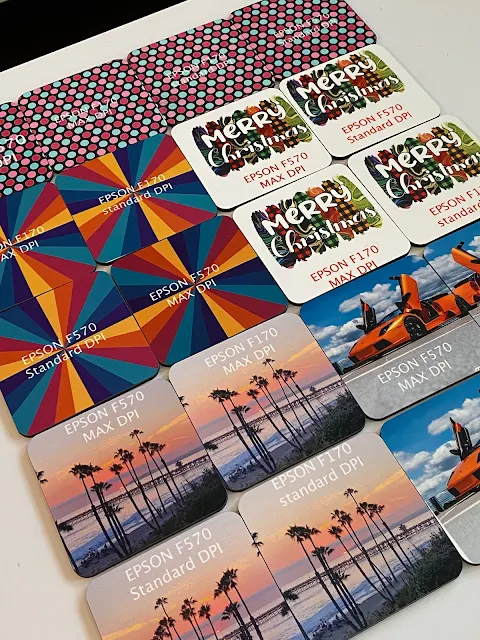



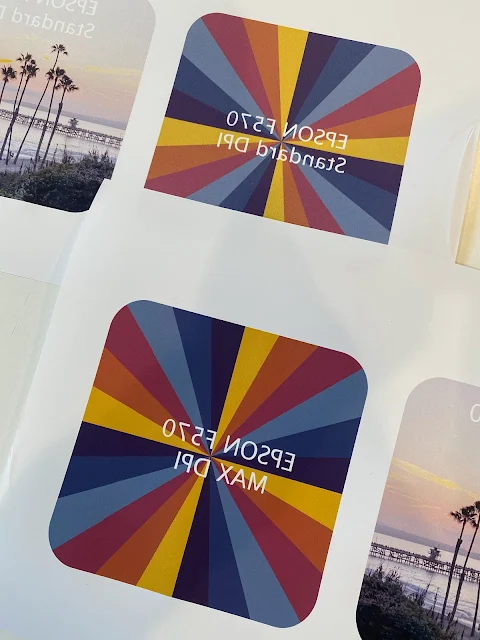
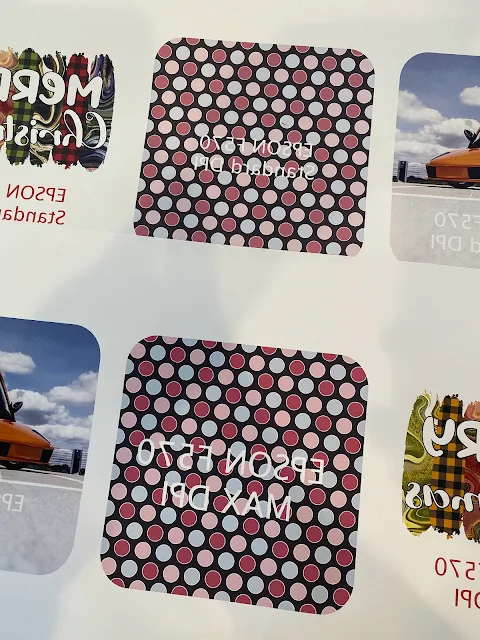
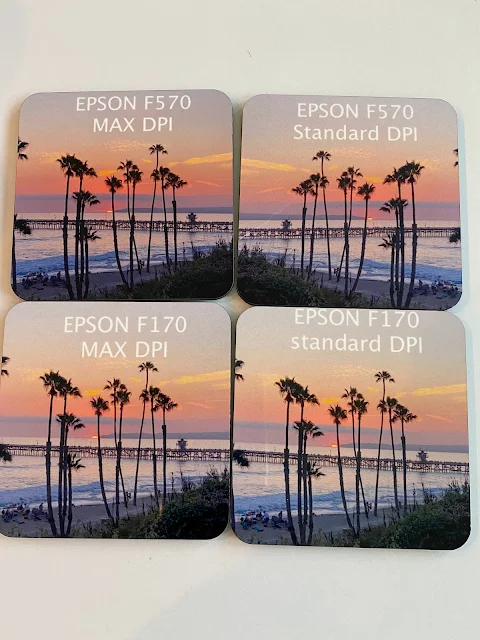







.png)




What if you can't afford or don't have the room for the best sublimation printer? What do I do about purchasing a sublimation printer I can afford and have room for?
ReplyDeleteThe F170 is desktop so you don’t need a lot of space for it.
DeleteI just bought the Epson F170 and am waiting for it to be delivered. For me, price was the biggest factor. I have a Silhouette Cameo 4, a Glowforge Pro, a Heat Press, a couple of Cricut Easy Press 2. Crafting is an expensive hobby/side hustle! I just could not justify paying so much for a sublimation printer right now. I would tell anyone that it’s better to start off cheaper and then if you are doing well with it and making money, then upgrade to the higher priced F570. If you are making products that are in high demand or in a unique niche then you can take the money and buy the F570. Too many times, I’ve spent money on the higher priced product (Glowforge Pro) when I should have started off at the lower price point. Anyway, this would be my recommendation. I bought the Epson F170 because of price point, support, and warranty vice converting my Epson printer that I already own. Eventually, I will probably purchase the F570.
ReplyDeleteAgree! Start where it's more affordable and work your way up.
DeleteThank you for all the information. I'm looking to purchase a desktop sublimation printer. My question is, am I still limited to using 85% polyester blanks, and white or pale color blanks? Thank you
ReplyDeleteGot the F170, thought it was printing really good, almost as good as our converted WF-7710's. Got a complaint from a customer that their item looked green. So we started looking at our stuff, and depending on the light, the item looked perfect gray like it should. Shined a different light like warm/daylight/ etc. the was extremely green. There's no way to turn down the yellow, so were trying to figure this out because it would be nice to keep using it.
ReplyDelete